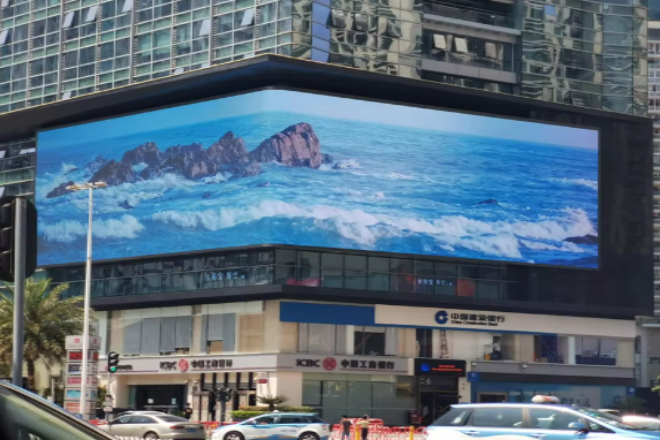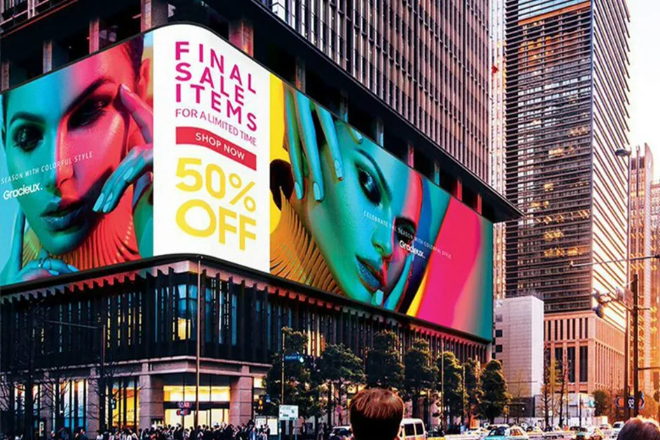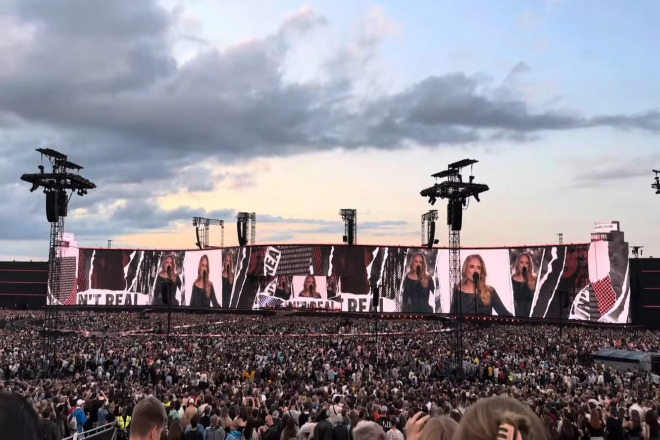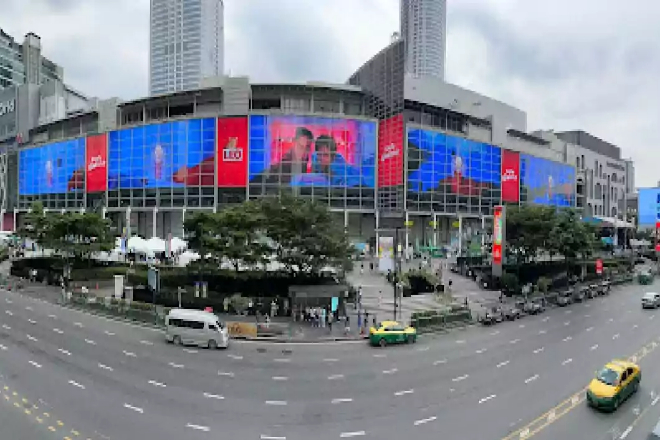Introducción

We all know that using pantallas de visualización LED to play advertisements is very effective, but do you know? Another factor that makes your advertising more effective is how large the information coverage area of your LED display screen is.
The larger the coverage area, the wider the range of your advertisement, so Maximizing the information coverage area of the LED display screen and improving the efficiency of information transmission are very important issues.
1. Why is the information coverage area important for LED display screens?
1). The impact of information coverage area on information transmission efficiency
Speaking of information coverage area, it is actually the size of the “territory” where the LED display screen can display how much content. The larger the “territory,” the more information can be placed, just like if you have a large table, you can put more things on it.
What does this mean in terms of information transmission? It means that the audience can see more and more complete content in a shorter time.
For example, if the large-screen advertisement on the street covers a large area, it can display more product information at once so that people can see it at a glance. In this way, the efficiency of information transmission is improved, and the audience can get the key points faster.
2). Advantages of large-area display screens in advertising, performances, meetings, and other occasions
Large-area LED display screens can really be used anywhere and are easy to use everywhere.
Advertising occasions: Just imagine when you are walking on the street, you suddenly see a super large screen with cool advertisements playing on it.
Isn’t that very attractive? Large-area display screens can be so eye-catching and double the advertising effect. Product information and brand image can be deeply rooted in people’s hearts at once.
- Performance occasions:
During performances, the large screen is the “background board” of the stage, but it is not an ordinary background board.
It can display the content of the performance and the introduction of the actors and can interact with the performance in real time, making the audience feel like they are in the scene. The shocking visual effect is really incomparable to the small screen.
- Meeting occasions:
During meetings, large screens are also a must-have artifact. It can clearly display the meeting agenda and speaker information and play data reports. In this way, the content of the meeting is clear at a glance, and everyone can listen to the meeting and discuss more attentively.
3). The significance of increasing the information coverage area to enhance visual impact and attract the audience’s attention
The larger the information coverage area, the better the visual effect of the LED display screen. Large-area, high-resolution screens can display super-delicate, realistic images and videos, which will amaze people at first sight.
Moreover, large screens can attract people’s attention. In a pile of information, the large screen is like a “bright spot” that can catch people’s eyes at once. In this way, the dissemination effect of information is better, and the audience can watch, listen, and feel more attentively.
So, when choosing an LED display, the information coverage area is really an important consideration. Bigger is better, it is attractive!
2. What are the factors that affect the information coverage area of the LED display?

1). Physical size
The physical size of the LED display, in simple terms, is its size, which directly determines the information area it can cover. A larger display means that it has more space to display images, text, or video content. Displays of different sizes are suitable for different scenarios:
Small LED displays, such as those used in indoor meeting rooms or small stores, although the area is not large, are enough to meet the needs of close viewing, and the cost is relatively low.
Large LED screens, such as outdoor billboards and giant screens in stadiums, can cover a wider audience and are suitable for long-distance viewing, but the corresponding cost will be higher.
When choosing an LED screen, it is necessary to determine the appropriate size according to the actual usage scenario and to ensure that the information coverage area meets the requirements without causing unnecessary waste.
2). Resolution and pixel density
Resolution and pixel density are key factors affecting the clarity of information displayed on LED screens, and they also indirectly affect the effective use of information coverage area.
Resolution refers to the number of pixels in the horizontal and vertical directions on the display screen, usually expressed as “horizontal pixels × vertical pixels.” The higher the resolution, the more details the display can display and the clearer the image.
This means that at the same physical size, a high-resolution display can display more effective information, thereby improving the actual utilization of the information coverage area.
- Densidad de pixeles:
Pixel density refers to the number of pixels per unit area, usually expressed as “dots/square meters.” The higher the pixel density, the denser the pixels on the display screen and the more delicate the image.
This also helps to improve the clarity of information display, allowing viewers to clearly see the content on the screen at a greater distance. Under the same information coverage area, high-density pixel display screens can show more details and improve the readability and attractiveness of information.
3). Installation method and layout
The installation method and layout of LED display screens will also affect the effective use of its information coverage area.
- Método de instalación:
Different installation methods, such as wall-mounted, suspended, embedded, etc., will have different effects on the display effect and audience vision of the display screen. For example, wall-mounted installation is suitable for indoor walls, which can save space and is easy to install.
Suspended installation is suitable for large outdoor billboards or stadiums, which can provide a wider viewing angle and a larger coverage area. Choosing a suitable installation method can ensure that the information coverage area of the display screen is maximized.
- Layout:
Optimizing the layout is also an effective means to increase the information coverage area. For example, when multiple display screens are spliced, a reasonable layout can reduce seams and blind spots and improve the coherence and consistency of the overall display effect.
In addition, by adjusting the tilt angle and viewing distance of the display screen, the audience’s field of vision can also be optimized, making the information coverage area more uniform and effective.
4). Content design and arrangement
In addition to hardware factors, content design, and arrangement are also important factors affecting the information coverage area of LED display screens.
- Diseño de contenidos:
Excellent content design can attract the audience’s attention and improve the efficiency of information dissemination. For example, the use of dynamic graphics, design elements with strong color contrast, etc., can make the information more prominent and easy to understand.
- Arrangement strategy:
An effective content arrangement strategy can make full use of the information coverage area of the display screen.
For example, by dynamically switching different information contents, more information can be displayed in a limited time, and the partition display strategy can divide the screen into multiple areas while displaying different information contents, improving the diversity and richness of information.
These arrangement strategies are helpful in improving the coverage area and dissemination efficiency of information.
3. Methods to maximize the information coverage area of LED display screens
1). Choose the right display screen size and resolution
When choosing an LED display screen, size and resolution are the keys. You have to see where it is used, whether it is a small indoor meeting or a large outdoor billboard. Different needs will result in different sizes.
Don’t forget that you may want to upgrade or add screens in the future, so you have to choose an expandable system that will be convenient to adjust in the future. The resolution must also keep up. High-definition looks comfortable, and the information is displayed more clearly.
Don’t just choose a blurry one to save money. The audience can’t even see it clearly, so what information coverage can you talk about?
2). Optimize the installation layout
The installation layout is also a big deal. You have to look at the characteristics of the place, whether it is a wall, ceiling, or outdoor space, and then design the most suitable installation plan.
Sometimes, innovative installation methods, such as a curved screen or a special-shaped screen, not only look cool but also increase the display area. Don’t always follow the rules; try new methods; maybe there will be unexpected results.
3). Use an advanced content management system
The content management system, referred to as CMS, must be selected. It can help you remotely manage the content on the screen and change it whenever you want, which is very convenient. It can also be intelligently scheduled, such as which screen should play, what, and when to play.
All can be set. In this way, your information can be displayed more timely and attract more people’s attention. When choosing a system, you have to see if it supports these functions; don’t choose one that can’t do anything.
4). Innovative content design and arrangement
Content design and arrangement are also the keys to increasing the coverage area of information. Don’t always put some static pictures or texts; try dynamic graphics, videos, and other multimedia elements to make the screen come alive.
When the audience sees it, they will definitely be willing to take a few more glances. In addition, you can divide the screen into several areas and put different information in each area.
For example, put the event process on one side and the guest introduction on the other side so that the audience can see all the information they care about at a glance. This design not only covers a larger area of information but also makes the audience happier.
4. Análisis de casos

1). LED giant screen at the concert of British singer Adele
At the concert of British singer Adele, a giant LED screen with a main screen area of 4159.7 square meters broke the Guinness World Record of “the world’s largest outdoor LED screen.” This screen has a wavy design, like an unfolding scroll, which brings extremely shocking visual effects to the audience.
1.1). Innovation and practical experience:
- Ultra-large area:
By adopting an ultra-large area LED display screen, the information coverage area is maximized. This giant screen not only attracts the attention of a large number of audiences but also adds an artistic and dynamic sense to the performance through its unique wavy design.
- Diseño personalizado:
The screen fully considers the needs of the performance and the audience’s perspective, ensuring that the audience at every angle can get a good viewing experience. This customized design idea is worth learning from in various large-scale events.

2). Outdoor transparent LED screen at Central World Shopping Center in Thailand
In Central World Shopping Center in Thailand, the outdoor transparent screen carefully built by Absen has a strong visual impact. The total area of this screen is equivalent to 6 standard basketball courts. Once it is lit, it becomes the most eye-catching scenery on the bustling Bangkok Avenue.
2.1). Innovation and practical experience:
- Transparent screen technology:
Transparent screen technology allows the screen to display information while maintaining the transparency of the building’s appearance and will not block the audience’s sight. This technology has broad application prospects in commercial blocks, shopping centers, and other places.
- Large area coverage:
By adopting a large area of transparent screen, the information coverage area is maximized. This not only enhances the brand image of the shopping center but also provides more advertising display space for merchants.
3). Case summary and reference:
The common point of these successful cases is that they all maximize the information coverage area by adopting advanced LED display technology. At the same time, they fully consider the use of scenarios and audience needs, and through customized design and innovative applications, they enhance the information dissemination effect and the audience’s viewing experience.
For readers, the following practical experience can be drawn from these cases:
- Choose the right display technology:
According to the usage scenario and needs, choose the right LED display technology, such as a transparent screen, curved screen, etc., to achieve a better display effect.
- Diseño personalizado:
Take full account of the audience’s perspective and usage scenario and carry out customized design to improve the information dissemination effect and the audience’s viewing experience.
- Entrega precisa:
In areas with high traffic, maximize the information coverage area through precise advertising.
- Continuous innovation:
Pay attention to industry dynamics and technology development trends, and constantly try new applications and innovative designs to maintain competitiveness and meet the ever-changing market needs.
Conclusión
Through the discussion in this article, we deeply understand the importance of maximizing the information coverage area of LED display screens. It is not only related to the efficiency of information transmission but also directly affects the audience’s visual experience and the dissemination effect of information.
In terms of selecting display screen size and resolution, optimizing installation layout, adopting an advanced content management system, and innovating content design and arrangement, we have proposed a series of practical methods and strategies.
Finalmente, si quieres saber más sobre las pantallas LED, Por favor póngase en contacto con nosotros.
